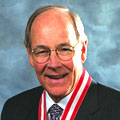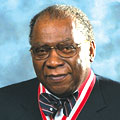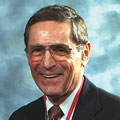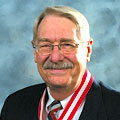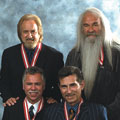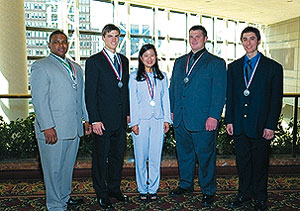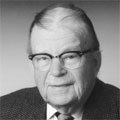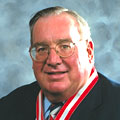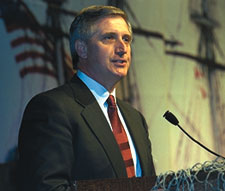![]() September 2001
September 2001
Writing the Next Chapter
By Jon C. Halter
Photographs by John R. Fulton Jr., Roger Morgan, and Michael Roytek
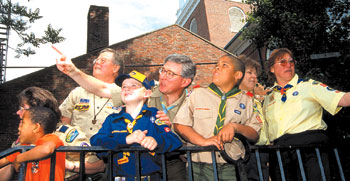 By historic Old North Church, Boston-area Scouts and Scouts show BSA visitors why the city's venerable past retains an appeal to older and younger generations alike. Front: Tiger Cub Poochie Keller, Pack 11, Everett, Mass., Cub Scout Robert DeBevoise, Pack 52, Dover, Mass.; Boy Scout Bo Keller, Troop 11, Everett. Rear: Sue Hauser, Beaverton, Ore.; Charles Love, Ithaca, N.Y.; Chuck DeBevoise, Pack 52; Diane Cannon, The Woodlands, Tex.; and Janine Keller, Cubmaster, Pack 11. |
The BSA's new Strategic Plan 2002-2005 helps Scouters at the national annual meeting plan the next—and best—installment in the epic story of Scouting as the nation's top youth-serving organization.
- Framework for the Future: The 2002-2005 Strategic Plan
- Silver Buffalo and Young American Awards
- Eagle Scouts Offer Evidence of How Scouting Makes a Difference
- Highlights and Accomplishments
- Tiger Cubs: Becoming Even Better
Scouters touring Boston during the 2001 National Annual Meeting of the Boy Scouts of America in late May encountered numerous streets blocked by something called "The Big Dig." The Central Artery/Tunnel Project (its official name) will produce an underground expressway to dramatically improve traffic flow and air quality in one of the nation's oldest and most congested major cities.
The Big Dig shows how a city with countless treasured historical buildings and locations, some dating back 300 years or more, can renew and improve itself without destroying the qualities and values that distinguish it from its counterparts.
Preserving timeless values while continually working toward improvement. For more than 2,000 Scouters and spouses, that concept also expressed why they had assembled in Boston for the BSA's 82nd national annual meeting.
Facing Challenges
The meeting's opening event, the Duty to God Breakfast, featured as guest speaker Commissioner John Busby, national commander of The Salvation Army. He described how The Salvation Army greatly values its relationship with Scouting, a partnership begun in 1929. (See Partners in Service in this issue for more information about the relationship between the BSA and the Salvation Army.)
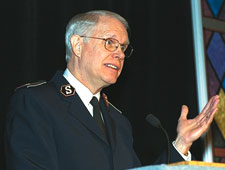 Salvation Army National Commander John Busby praised the BSA's stand on values. |
Busby also praised the BSA for maintaining its traditional values-based program in the face of challenges by proponents of "moral relativism," a philosophy "which is assumed by many to be an absolute." In response, "The Boy Scouts of America has drawn a line in the sand, and we congratulate you for it."
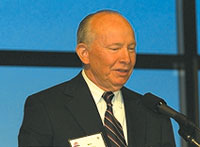 BSA President Ward: despite challenges, Scouting continues to fulfill its mission. |
External challenges to Scouting's program were also addressed at the National Annual Business Meeting by BSA President Milton H. Ward. Following the U.S. Supreme Court decision in June 2000, confirming the BSA's right to set its own membership and leadership standards, Scouting faced "widespread attacks" from detractors seeking to "censor our message and intimidate our traditional supporters," Ward said. "I'm very proud of the way that we have stood up to these challenges and the way that we continue to fulfill our mission of serving youth."
Despite the challenges, "2000 was a great year for Scouting," Ward announced. "Total council net assets increased in all three funds—operating, properties, and endowment" and "even with all the focus on our constitutional issues, local United Way [contributions to Scouting] increased." The BSA endowment emphasis also continued to be successful, as "accumulated cash in deferred gifts to local council funds totaled more than $2.2 billion dollars."
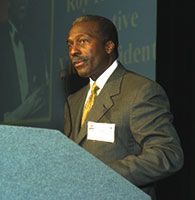 Strategic Plan 2002-2005 was introduced by plan committee chairman Roy Roberts. |
A plan and its tools
Scouting's goals for the immediate future were summarized in the new National Strategic Plan 2002-2005, introduced by Roy S. Roberts, executive vice president of the BSA National Executive Board and chairman of the Strategic Plan Committee.
Some tools and methods for achieving the Strategic Plan's objectives were explored in five seminars and 16 elective workshops. They covered a variety of topics, such as building chartered organization relationships, developing Cub World and Cub Scout Resident Camp programs, new directions in training, opportunities for growth in council Venturing programs, and use of unit management software and the BSA's ScoutNET system.
The Council Commissioner Leadership workshop focused on the critical role commissioners play in traditional unit membership growth.
"Quality program and quality leadership are the two variables that can determine the success or failure in achieving our mission," BSA National Commissioner William F. (Rick) Cronk told an audience of council and district commissioners. Commissioners are "the quality control mechanism in Scouting," he said. The individual support they provide leaders is critical in preventing dropped units, and "the way that we can most dramatically improve the number of youth in Scouting is to avoid losing them as often as we do."
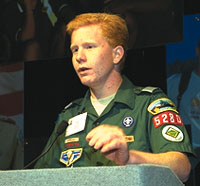 Eagle Scout Tim Brox told Scouters he was ready for his historic year in Antarctica. |
Youth tells its story
The outstanding Boy Scouts and Venturers honored at the meeting offered evidence of just how valuable the efforts of adult Scout leaders are in determining the program's success.
At the annual Scouters' Luncheon, Venturer Hong-Ly Thi La, speaking for herself and the four other recipients of the 2000 Young American Awards said, "We believe Scouting plays a very important role in our lives, helping to prepare us to be ready for any challengeOe[and] we are proud to be a part of the Boy Scouts of America."
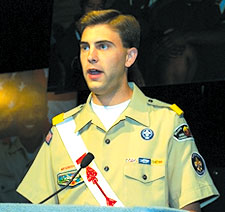 Carey Mignerey: a memorable 130 days of travel during a year as national OA chief. |
Another noteworthy young speaker, Tim Brox of Fresno, Calif., told how he looked forward to being the ninth Eagle Scout since 1928 to represent the BSA as a participant in a scientific pro ject in Antarctica. And Carey Mignerey of Roswell, Ga., described the valuable lessons he learned from individuals he met in 2000 during 130 days of travel as national chief of the Order of the Arrow.
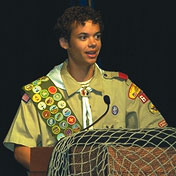 Service to others is important to top Eagle Scout scholarship winner John Linkhart. |
Scouters at the Americanism Breakfast heard from John Linkhart, Eagle Scout from San Antonio, Tex. Selected from more than 2,700 applicants, he received the 2000 Mabel and Lawrence S. Cooke Scholarship, a four-year, $48,000 grant that represents the top award among the numerous grants available in the National Eagle Scout Association scholarship program. "Service to others is a big thing for me," John said. "I genuinely like helping other people."
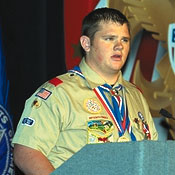 Evan Michael Todd expressed gratitude for character values he learned in Scouting. |
The most dramatic presentation, however, came from Eagle Scout Evan Michael Todd, a recipient of both a national Young American Award for achievements in and out of Scouting and a BSA Honor Medal for his actions in helping fellow students during the 1999 shooting at Columbine High School in Littleton, Colo. His message to Scouters at the business meeting contained both a concern about the lack of traditional values in American society and an appreciation for values he learned through Scouting.
What we are all about
The sentiments expressed by Evan and other youth leaders exemplified "what we and Scouting are all about, shaping the lives of young people," said Chief Scout Executive Roy L. Williams in his concluding remarks.
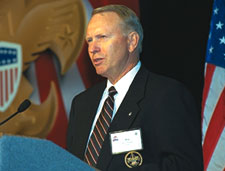 Chief Scout Executive Roy L. Williams thanked volunteer leaders, whose efforts reflect "the spirit of cheerful service that is the heart of Scouting" and who represent "the very soul of our organization." |
"Scouting is not a single story, but rather a hundred million stories, stories of Scouts, leaders, and parents, and even chartered organizations," he noted. "They are the stories of goals set and achieved, of lessons taught and learned, of lives touched and changed forever." Scouting's current critics "would like you to believe that our story is finished," Williams said. "But I've got news for you—the story's just beginning."
He expressed his deep appreciation for Scouting's countless volunteer leaders, who "embody the spirit of cheerful service that is the heart of Scouting; they are the very soul of our organization." And together, with the latest Strategic Plan as a guide, "We're going to write the next chapter of this epic story of Scouting."
Jon C. Halter is the editor of Scouting magazine.
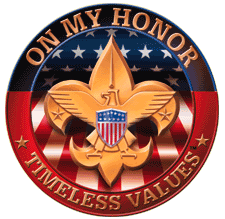
Framework for the Future: The 2002-2005 Strategic PlanThe BSA Strategic Plan 2002-2005, introduced at the National Annual Meeting in May, identifies issues and outlines strategies that will shape the future of the Boy Scouts of America. Based on input from local councils and individuals across the country, it lists the five key issues of greatest concern. The Strategic Plan 2002-2005 is a framework for the future of Scouting; like the 1998-2002 plan, it focuses on five critical issues. Traditional Membership and Unit GrowthThe bond between local communities and the Boy Scouts of America is built on the traditional Scouting program, which includes Cub Scouting, Boy Scouting, Varsity Scouting, and Venturing. The growth of the traditional program furthers our values and faith-based mission to serve young people and their families. ScoutreachThe BSA has always been committed to providing a program for all economic and racial groups. As America's population becomes increasingly diverse, we are even more concerned about our continued service to minority communities, because it is the right thing to do. Serving our minority communities is the best way of ensuring a move toward a representative membership—a membership that encompasses all ethnic groups. LeadershipLeadership is key to the continued success of the Boy Scouts of America. Leaders create a specific and unique vision for the future of the organization and develop the strategies needed to achieve that vision. Leaders have to understand the mission and vision and communicate it throughout the organization and beyond. To succeed, we must have enough of the right kind of volunteer and professional leaders who are well-trained and motivated to achieve the vision and mission of Scouting. Marketing and Strategic PositioningFuture growth of the Boy Scouts of America is dependent on how we are perceived by our customer groups. It is vital to ensure an understanding among parents, youth, chartered organizations, donors, and the general public that Scouting offers a unique value to youth and their families. The goal of our marketing message is to build awareness and solidify the fact that the Scouting program supports the physical, mental, and spiritual development needs of young people and their families. By offering such comprehensive benefits, BSA membership is an investment that will pay dividends in the future. Financial DevelopmentThe future of the Boy Scouts of America depends on strong councils with adequate financial resources. Well-financed councils will have the ability to employ a full, well-trained staff; provide exceptional program facilities; conduct a first-class program; and attract quality program and administrative volunteers. Particular attention will need to be paid to identifying, cultivating, and soliciting donors at all levels (operating, capital, and endowment), who are supportive of the mission and values of Scouting. The emphasis must be placed on individual donors rather than corporate or community resources. The environment in which our organization exists is becoming increasingly competitive. The fierce competition local councils face every day for resources reinforces the need for a bold vision and strong leadership. By taking action on these critical issues, the Boy Scouts of America will continue to have the strength and flexibility needed to provide young people and their families a values-driven program of character development and leadership. |
Silver Buffalo AwardsThe BSA honors adult leaders and young people for high achievements and service.
| |||||||||||||||
Eagle Scouts Offer Evidence of How Scouting Makes a DifferenceThe National Eagle Scout Association's (NESA's) annual Americanism Breakfast featured both a Distinguished Eagle Scout Award presentation and an address by a distinguished speaker.
Honored with the Distinguished Eagle Scout Award was Dr. Rodney H. Brady, Ph.D., president and chief executive officer of Deseret Management Corp. He is currently a member of the BSA's Western Region Executive Board, the Great Salt Lake Council Executive Board, the Cub Scout Marketing and Scoutreach committees, and the National Advisory Council. His previous honors in Scouting include the Silver Beaver, Silver Antelope, and Silver Buffalo awards. Keynote speaker was Boston-area native Andrew H. Card Jr., who is chief of staff to President George W. Bush. He was introduced by NESA president Robert M. Gates as "the man who runs the White House." Card described growing up in the small town of Holbrook, Mass., where he was a member of Boy Scout Troop 13 and served for many summers on staff at the Old Colony Council's Camp Child.
"Scouting has contributed much more to me than I can ever give back," he said, noting that his father was an Eagle Scout and "a great Scouter who contributed a lot to the Scouting organization, so I feel very blessed that he instilled in me a sense of duty, honor, and service." Scout leaders contribute "opportunities for life" to others, Card said. "It's not always easy to be a Boy Scout today, but it's Scouters who make it possible" and "I have the utmost respect for those who serve their community by being Scouts and Scouters." NESA President Robert M. Gates reported these Eagle Scout highlights for 2000:
In meeting new Eagle Scouts during visits to 90 councils across the country, Gates said, "I have seen our future firsthand, and it is bright beyond description. The time and energy that you and other volunteers—especially Scoutmasters all across this country—are devoting to these boys and young men is paying dividends the magnitude and importance of which we can only barely begin to discern. You should be very proud." |
Highlights and AccomplishmentAmong the BSA national meeting highlights were these accomplishments for 2000:
|
Tiger Cubs: Becoming Even BetterThe Tiger Cub program is changing for the better in 2001—while retaining its most important elements. The changes, previewed at the National Annual Meeting, feature a new look and program enhancements that include an advancement plan to create additional challenges and excitement for first-grade boys. 
New Program Highlights
New Leader ResponsibilitiesThe Tiger Cub den leader will:
|
September 2001 Table of Contents
Copyright © 2001 by the Boy Scouts of America. All rights thereunder reserved; anything appearing in Scouting magazine or on its Web site may not be reprinted either wholly or in part without written permission. Because of freedom given authors, opinions may not reflect official concurrence.
| The Boy Scouts of America | http://www.scouting.org |
